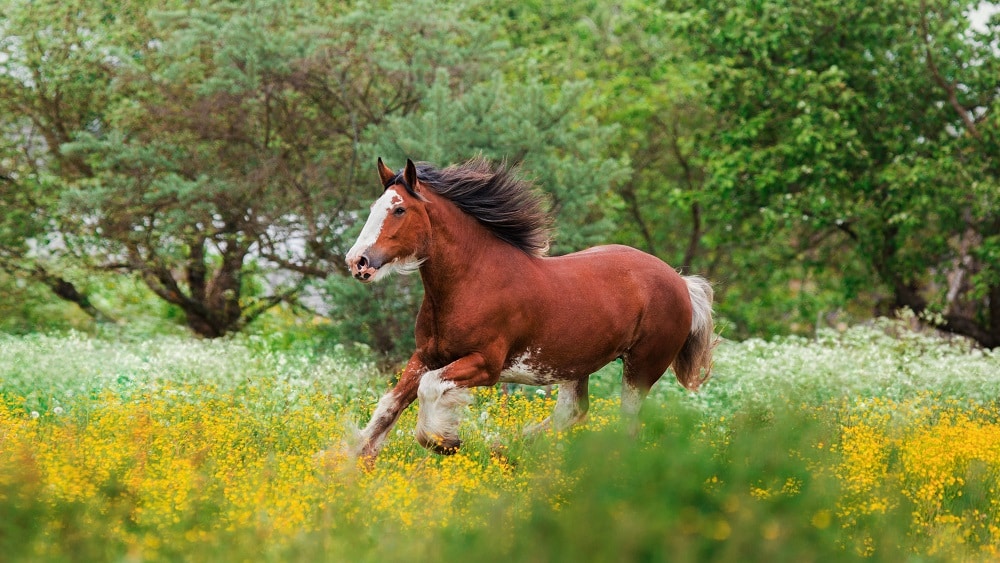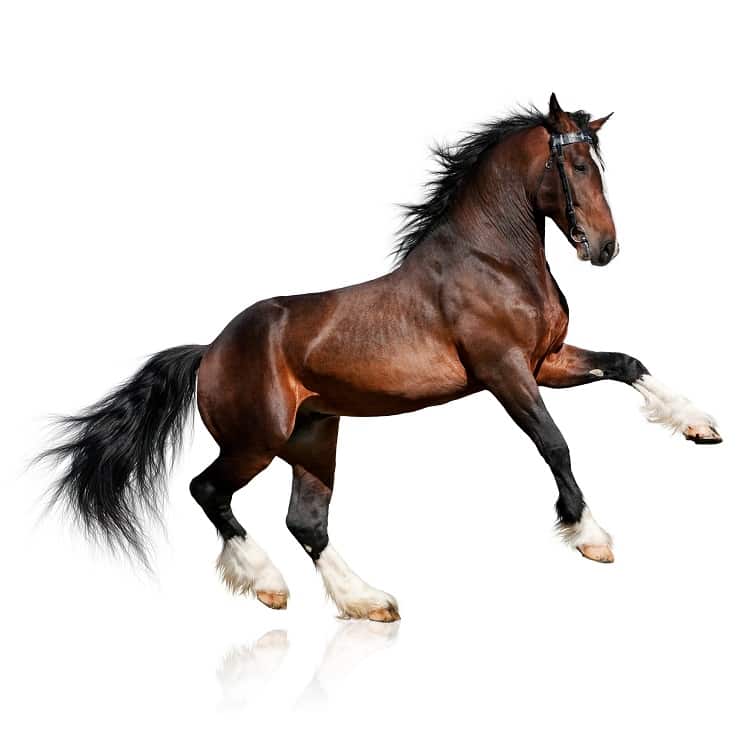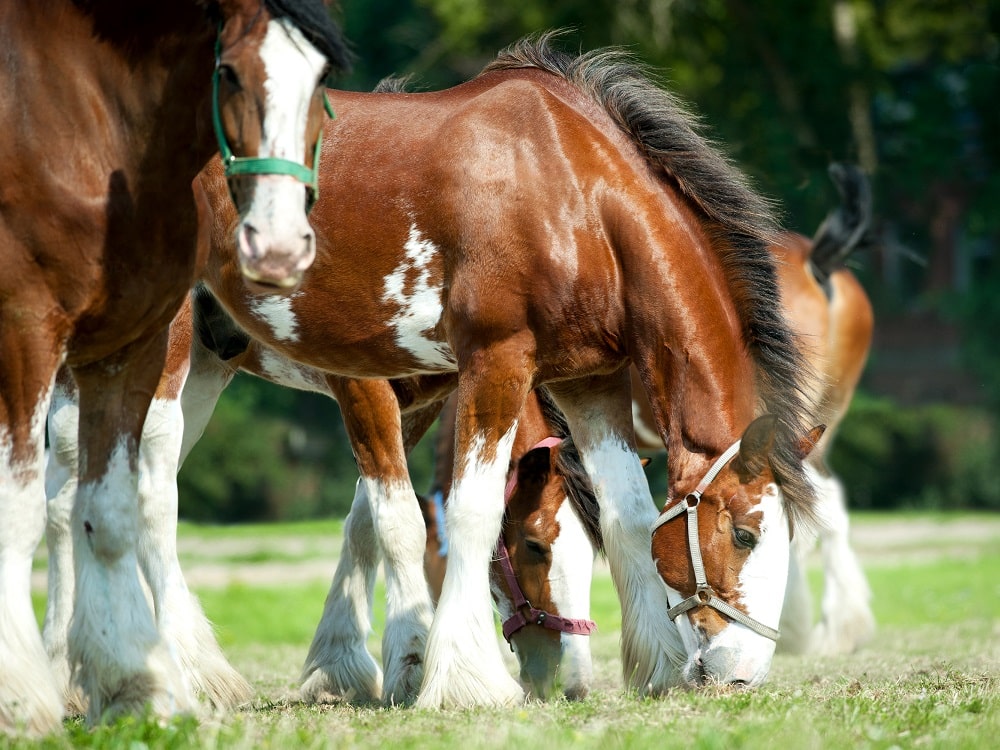
Vital Stats
| WEIGHT: |
700 – 1000kg |
| HEIGHT: | 16 hands – 18 hands (16.2hh average) |
| LIFE EXPECTANCY: | 25 – 30 years |
| BEST FOR: | work, pulling heavy loads, leisure riding, therapeutic work |
| ORIGIN: | Scotland (Lanarkshire) |
Order now for delivery on Thursday 11th December
Originally bred as a draught horse for use on farms and in industry, the Clydesdale horse originated in the Scottish county of Lanarkshire in the late 18th century, when Flemish stallions were brought to Scotland to mate with local draught mares. Their hard working temperament, combined with their large size and considerable strength, meant that they were often used for manual tasks such as road haulage and logging.
Their use in WW1 to haul guns and artillery resulted in heavy losses, and the number of Clydesdale horses in existence fell as a result. As with fellow heavy horses such as the Shire horse, Clydesdale numbers were also impacted by the rise in popularity of machinery in both industry and agriculture. Today, they are on Rare Breeds Survival Trust’s Vulnerable list.
While the Clydesdale was developed in Scotland, today it is most commonly found in the U.S., followed by the UK, Canada and Australia. In fact, the American lager manufacturer Budweiser boasts its own team of Clydesdale horses who are used to promote the brand, taking part in parades, promotions and adverts across the United States and beyond.
The Clydesdale horse is also celebrated at the World Clydesdale Show.


| WEIGHT: |
700 – 1000kg |
| HEIGHT: | 16 hands – 18 hands (16.2hh average) |
| LIFE EXPECTANCY: | 25 – 30 years |
| BEST FOR: | work, pulling heavy loads, leisure riding, therapeutic work |
| ORIGIN: | Scotland (Lanarkshire) |
The Clydesdale horse was originally developed in Scotland, in the Clyde valley after which they are named. Flemish stallions were imported to mate with local draft mares in the 18th century, with the first use of the word “Clydesdale” as a horse breed recorded in 1826. After this, Shire blood was introduced in the 19th century; and a breed society was introduced in 1877.
After becoming popular in Scotland, the Clydesdale spread to northern England; it was also exported in large numbers to countries such as Australia, New Zealand and America during the late 19th and early 20th centuries.
Their original purpose was as a working horse, carrying out manual labour in farming and industry. During the First World War, the Clydesdale horse was conscripted to work on the battlefield hauling guns, and the breed experienced heavy losses as a result. This was exacerbated by the rise in machinery and the decline in the use of horses for labour, and by the 1970s the Clydesdale horse breed found itself listed as “At Risk” with the Rare Breeds Survival Trust – a status which endures to this day, and means that there are fewer than 1500 breeding mares of the Clydesdale horse breed
Today, Clydesdale horses are more commonly used as carriage horses; for leisure riding; as drum horses; and in parades, with their white feathered feet making quite an impression. The British Household Cavalry uses them as drum horses alongside Shire horses; while the Anheuser-Busch brewery boasts its own team of Clydesdales who are used to promote Budweiser beer.
Clydesdale horses are often crossed with other breeds: the Clydesdale Quarter Horse cross, Clydesdale Thoroughbred cross, and Friesian Clydesdale cross are a few examples.
Clydesdale horses are known for their large size: with an average height of around 16 – 18 hands, this Scottish horse breed is one of the tallest in the world.
The biggest Clydesdale on record is Remington from the USA, who measured 20 hands in 2009 and was once the tallest living horse in the world. His title was challenged unofficially by Poe the Clydesdale, who was measured by his owner at 20.2 hands that same year.
The Clydesdale displays a strong, muscular appearance, with a straight or slightly convex facial profile; and an elegant, showy gait. They feature significant white feathering on their lower legs, which is a characteristic preferred by a number of Clydesdale breeders.
When it comes to colour, Clydesdale horses are usually bay, although black, grey and chestnut Clydesdale horses are not uncommon. It is the bay and black horses who command a premium, especially when combined with white facial markings and four white legs – two features which are common in the Clydesdale horse.
However, Clydesdale breed associations do not prefer any one colour; and are happy to accept roan horses, as well as those with body spots.
Clydesdale horses eat a regular equine diet of quality hay, grain, vegetables and fruits. Their large size and resulting high energy requirements mean that they need more food than smaller horses, which can make them more expensive to keep.
The large size of the Clydesdale horse is perhaps this breed’s most recognisable characteristic, alongside their considerable strength – which has made them popular work horses to this day.
As well as their remarkably large size, Clydesdales display a number of unique characteristics which set them apart from their equine peers.
The Clydesdale horse features significant white feathering on their lower legs: this is both a distinctive feature of this horse breed, making them popular at horse shows and in parades; and a desirable trait to many Clydesdale breeders. The Budweiser Clydesdales, for example, are strictly bred to be bay with white feathering.
The Clydesdale horse is also known for its large hooves, which can measure over 20 inches in diameter.
The impressive size of a Clydesdale horse may seem intimidating, however this is a gentle horse breed with a calm, easy-going nature. Their breeding as a draught horse means they are hard working and eager to please; they do not spook easily, and are sure footed – which means riding a Clydesdale makes for a smooth experience.
This intelligent breed is easy to train, while their calm demeanour makes them great for riders of all levels; as well as for therapeutic purposes.
Clydesdale horses are a generally healthy breed, however there are a few health issues to look out for with Clydesdale horses.
Clydesdales can be susceptible to chronic progressive lymphedema: a chronic progressive skin condition in some breeds of draught horse, which causes swelling of the lower legs. There is currently no cure, however management can help to slow the onset.
Due to the heavy feathering on their lower legs, they can also be at risk of skin conditions in this area such as “Clyde’s Itch”, which is thought to be caused by a type of mange. Regular cleaning and grooming of this area will help to keep it healthy and in good condition.
Clydesdales can also get sunburn on their faces; using a good equine sun cream will help to keep this at bay.
Clydesdale horses require a little extra care and attention when it comes to grooming. Their distinctive leg feathering needs to be cleaned well on a regular basis to avoid a build up of dirt, which can lead to skin conditions such as “Clyde’s itch”.
The sheer size of the Clydesdale can also mean that grooming takes a little longer; while their large hooves require daily cleaning and inspection. Clydesdales also need larger horseshoes to match their impressive hoof size: Clydesdale horseshoes can measure over 20 inches in diameter, and weigh over 2kg!
The typical lifespan of a healthy Clydesdale horse is between 25 – 30 years.
Typically used for work, today there are plenty more reasons to choose a Clydesdale horse than for manual labour alone!
With a calm, easy going temperament the Clydesdale horse is a great choice for riders of all levels; and Clydesdale horse riding is a popular leisure pursuit. Their steady, reliable and sure footed nature also makes them a popular choice as a therapy horse. Intelligent, agile and easy to train, they are a good family horse, and are great for trail riding.
While they are not a common choice as a dressage horse, particularly when it comes to competition, Clydesdales are sometimes ridden for this purpose. In fact, the British Dressage Draught Horse Championships were created to allow draught horses such as Shires and Clydesdales to perform dressage in a competition setting.
Clydesdale horses are often chosen as drum or parade horses. The Budweiser Clydesdales perhaps the most well known example of this, while the British Household Cavalry also uses the Clydesdale at a number of ceremonial events.
While no longer their primary use, Clydesdales also find work to this day in agriculture; and are used as carriage horses thanks to their impressive strength.
